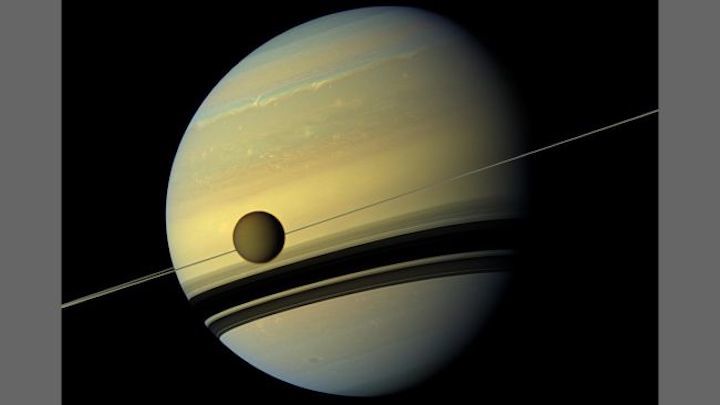12.06.2020
The moon's orbit around the planet is getting farther away faster than previously predicted.

Saturn's moon Titan is zooming away from its ringed parent 100 times faster than scientists expected.
According to a new study, Saturn's largest moon was "born" fairly close to the planet, but over the course of 4.5 billion years, it has migrated out to where it orbits currently, approximately 746,000 miles (1.2 million kilometers) away from the planet. The Saturnian moon's orbit is now expanding away from Saturn at a rate 100 times faster than scientists had previously predicted.
"Most prior work had predicted that moons like Titan or Jupiter's moon Callisto were formed at an orbital distance similar to where we see them now," Jim Fuller, assistant professor of theoretical astrophysics at Caltech and co-author on the new study. "This implies that the Saturnian moon system, and potentially its rings, have formed and evolved more dynamically than previously believed."
Moons exert a small gravitational pull on the planets they orbit, tugging at the planet. This gravitational interaction is what causes tides in the oceans here on Earth. On our planet, friction inside of Earth from this tugging creates heat, which alters the planet's gravitational field. This gradually pushes the moon farther away from Earth, about 1.5 inches (3.8 centimeters) every year.
Titan tugs on Saturn in a similar way, but the friction inside of Saturn is thought to be weaker than here on Earth because of the planet's gaseous composition(compared to Earth's rocky nature). Previous research has suggested that the moon should be moving away from Saturn at just 0.04 inches (0.1 cm) per year. But this new work suggests that Titan is actually moving away from its planet at a whopping 4.3 inches (11 cm) every year.
In this work, two teams of scientists worked to measure Titan's orbit over 10 years, with each team using a different technique. One team used a technique called astrometry, in which astronomers precisely measure the positions and movements of stars and other celestial objects to determine Titan's position in relation to those "nearby" objects, as seen in images taken by NASA's Cassini spacecraft.
The other team used radiometry, a set of techniques by which astronomers measure electromagnetic radiation, including visible light, to calculate Cassini's velocity as it zoomed by Titan. Knowing the spacecraft's velocity allowed the researchers to measure the moon's gravitational influence on the craft. This helped the team to study and measure the moon's gravitational pull.
"By using two completely independent data sets — astrometric and radiometric — and two different methods of analysis, we obtained results that are in full agreement," Valéry Lainey the lead author on the paper who worked with the astrometry team, said in the same statement. Lainey previously worked with NASA's Jet Propulsion Laboratory in Pasadena, California and now works at the Paris Observatory in France.
These findings also align with a theory that Fuller proposed in 2016, which estimated that Titan's outward migration was happening much faster than previously predicted. According to this theory, Titan gravitationally "squeezes" Saturn in a way that makes the planet oscillate, and the energy from these oscillations would cause the moon to migrate faster than previously expected.
This new work is described in a paper that was published June 8 in the journal Nature Astronomy.
Quelle: SC
